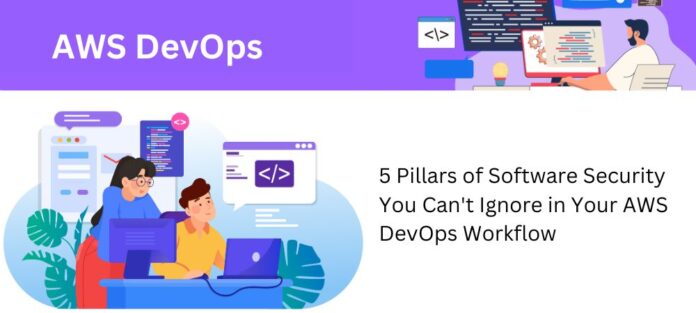In the consistently advancing scene of software development and sending, AWS DevOps specialists assume an urgent part in guaranteeing the consistent joining of safety efforts. The AWS DevOps workflow’s need for robust security measures grows more pressing as businesses embrace cloud-based solutions. In this article, we will dig into the five crucial mainstays of programming security that Aws DevOps consultants can easily overlook, offering experiences and best practices to strengthen your AWS DevOps work process.
Data Encryption: Safeguarding Information at Rest and in Transit
Sensitive data protection is an essential component of software security at rest and in transit. In an AWS DevOps work process, encryption is imperative for getting information both very still and on the way. Key contemplations include:
- Server-Side Encryption (SSE)
Empower SSE for capacity administrations like Amazon S3, guaranteeing that information put away in the cloud is scrambled. AWS offers different SSE choices, including SSE-S3, SSE-KMS, and SSE-C, permitting you to pick in light of your particular security prerequisites.
- Transport Layer Security, or TLS
It is a protocol for securing service-to-service communication, which is vital for safeguarding information as it crosses the organization. To relieve weaknesses, routinely update TLS adaptations.
- AWS Key Management Services (KMS)
Use AWS KMS to oversee encryption keys safely. Integrate KMS with other AWS administrations to partially oversee and control access to encryption keys.
Foundation as Code (IaC): Getting the Plan of Your AWS Climate
IaC, a DevOps foundation, considers the definition and provisioning of the framework through code. IaC security requires the following:
- AWS CloudFormation Best Practices
Follow AWS CloudFormation best practices to create a secure and repeatable framework. Implement definitions and use AWS-oversaw approaches for IAM jobs.
- Automated Security Checks
Integrate automated security checks into your CI/Album pipeline. Devices like AWS Config Rules and AWS Security Center can naturally consider AWS assets in contrast to security best practices.
- Version Control and Change Management
Carry out powerful variant control and change the executives rehearses for IaC scripts. Changes should be reviewed and audited on a regular basis to prevent unauthorized changes.
Incident Reaction and Automation: Fast Response to Security Episodes
Regardless of preventive measures, security episodes might happen. Having a clear cut occurrence reaction plan and it is basic to use computerization:
Automated Incident Reaction
Execute computerized reactions to normal security episodes. For instance, use AWS Lambda capabilities to naturally confine compromised assets or limit access during a likely break.
Runbook Automation
Make runbooks for episode reaction methodology. Within these runbooks, you can automate repetitive tasks to speed up response times and reduce manual errors.
Tabletop Exercises
Typically, tabletop exercises are used to reenact security incidents. This guarantees that your episode reaction group is good to go to really deal with different situations.
Identify and Access Management (IAM): Building the Strengthened Door
Multifaceted Authenciation (MFA)
The Critical Job of MFA in User Authentication
Multifaceted Authentication (MFA) remains a foundation in client validation, giving an extra layer of safety past conventional passwords. By expecting clients to confirm through numerous strategies, for example, passwords and brief codes, MFA essentially improves the assurance of delicate data.
Using MFA on All AWS Services
To protect your AWS environment, you need to use MFA on all of its services. Whether getting to the AWS executive’s Control centre or using AWS CLI orders, coordinating MFA guarantees that main approved people with legitimate qualifications can get entrance.
Least Privilege Rule
Seeing Least Privilege and Its Security Suggestions
The rule of least privilege is essential to IAM security; underscoring the allowing of negligible access consents is vital for clients to carry out their errands. Understanding the security ramifications of sticking to this guideline is essential for keeping a hearty IAM foundation.
Regular Audits and Surveys for Least Privilege Consistency
To guarantee persistent security, normal reviews and audits of IAM consents are basic. In order to guarantee that users retain only the access privileges that are necessary for their roles, periodic assessments assist in identifying and resolving any discrepancies.
IAM Jobs for Applications
Upgrading Security with IAM Jobs
IAM jobs assume an urgent part in upgrading security by giving brief security certifications to applications, administrations, or EC2 examples. This diminishes the dependence on long-haul qualifications and mitigates potential security gambles related with extremely durable access.
Defining IAM roles that are tailored to the particular requirements of applications in the AWS DevOps toolbox is part of the practical implementation of IAM roles. Incorporating IAM jobs consistently into work processes improves security without compromising functional productivity.
Data Encryption: Defending Data Very still and on the way
Server-Side Encryption (SSE)
Picking the Right SSE Choice for Your Data
Server-side encryption (SSE) is still instrumental in safeguarding information in AWS stockpiling administrations. Figuring out the different SSE choices, including SSE-S3, SSE-KMS, and SSE-C, assists associations with picking the most appropriate encryption strategy in light of their security necessities.
Best Practices for SSE Execution
Executing SSE expects adherence to best practices. This incorporates legitimate key administration, the standard pivot of encryption keys, and characterizing fitting access controls. If these procedures are followed, SSE will be successfully implemented across all AWS services.
Transport Layer Security (TLS)
The Crucial Job of TLS in Secure Correspondence
Transport Layer Security (TLS) is crucial in getting information on the way among administrations and applications. To preserve the confidentiality and integrity of transmitted data, it is essential to comprehend the significance of TLS in establishing secure communication channels.
Staying up with the latest for Strong Security
Normal updates to TLS variants are pivotal for moderating weaknesses and guaranteeing the most elevated level of safety. Remaining informed about the most recent TLS improvements and immediately embracing more current forms upgrades the general vigour of information encryption.
Managing Encryption Keys with the AWS Key Management Service (KMS)
The AWS Key Management Service (KMS) makes it simpler to manage the encryption keys that are utilized in AWS services. The effective protection of sensitive data is ensured by investigating the capabilities of KMS and putting best practices for key management into action.
Coordinating KMS with AWS Administrations for Upgraded Security
To lift safety efforts, coordinating KMS with different AWS administrations is fundamental. Improved control and visibility into data protection mechanisms are provided by this integration, which provides a centralized and secure method for managing encryption keys.
Continuous Monitoring and Logging of Eyes on Every Move
AWS CloudTrail logs provide a comprehensive record of API requests and AWS resource usage.
Understanding the force of CloudTrail logs permits associations to acquire experiences into client exercises, asset changes, and potential security dangers.
Proactive Safety efforts through CloudTrail Examination
Proactively utilizing CloudTrail examination empowers associations to recognize bizarre examples, distinguish potential security episodes, and answer quickly. Standard surveys of CloudTrail logs add to a hearty security pose in AWS conditions.
Real-Time Monitoring with Amazon CloudWatch with Amazon
CloudWatch, organisations can collect and track metrics, set alarms, and gain actionable insights into the performance of AWS resources through real-time monitoring. Efficiently utilising CloudWatch increases visibility and aids in the detection of security-related anomalies.
Making Custom Measurements and Cautions for Further Developed Perceivability
Custom measurements and cautions inside Amazon CloudWatch empower associations to fit observing endeavours to explicit security prerequisites. Making designated measurements and cautions upgrades perceivability into basic parts of the AWS climate, working with a proactive security position.
Security Information and Event Management (SIEM) Integration
Strengthening Security with SIEM Solutions By combining AWS with SIEM solutions, logs can be consolidated and centralized analysis can be performed. The ability to correlate events, identify security incidents, and swiftly respond to potential threats is enhanced by this integration.
Relating Occasions and Recognizing Examples for Quick Reaction
Relating occasions and recognising designs through SIEM arrangements enables associations to distinguish security episodes expeditiously. By laying out relationship administrators and computerising reactions, the security group can quickly answer possible dangers, limiting the effect on the AWS climate.
Conclusion:
In the unique domain of AWS DevOps, security should be proactive, imbued, and developing. AWS DevOps consultants can create a robust security framework by focusing on IAM, data encryption, continuous monitoring, infrastructure as code, and incident response. Adopting these five pillars will strengthen your AWS DevOps workflow now and position your company for a secure and adaptable future as technologies advance and threat landscapes change. Keep in mind, in the realm of programming security, proactive protection is the way to remaining one stride in front of likely dangers.
















